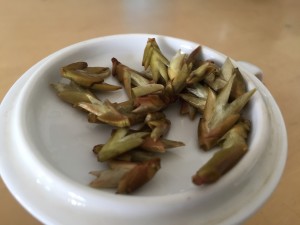The name white tea comes from the white down that is found on the buds that are often used in the production of this style of tea.
The only two production steps that happen for white tea are wilting and drying. They are not rolled, not steamed. Wilting occurs right after harvest in well-ventilated environments with low humidity or in mild climate on wilting mats in the sun. This process can take up to a couple of days. After wilting, the leaves are dried at low temperatures in ovens.
This is a very interesting category of tea: If teas are left to wilt for a very long time, they start to acquire a taste similar to oolong teas. If they are left to age after drying, they become very similar to sheng puers.
Preparation
Since the leaves are not rolled, the aromas and essential oils are not immediately released when brewing. Because of this, white teas are usually steeped for longer periods of time. For most teas, I found 3 grams with 100 ml water at 90°C for 6 minutes very agreeable, for example in a gaiwan or a little ceramic teapot.
Famous White Teas
The two most famous white teas are certainly the following:
-

Bai Hao Yin Zhen from Fujian Bai Hao Yin Zhen (白 毫 銀 針) (White Hair Silver Needle). This one uses only the closed buds, which because of their silver down look like needles (hence the name) and originally originates from Fuding, Fujian. I find this one to be usually quite floral, hay and elderflower, and some tamed stone-fruit in the back.
- Bai Mu Dan (白牡丹) (White Peony). This one uses one bud, two leaves, and is originally from Zheng He, Fujian. It is wilted for 1 to 3 days, and thus more heavily oxidized than the Bai Hao Yin Zhen. Because of that, it is usually more intense in taste; more honey and fruit.
The two main cultivars are Funding Dai Bai (Large White Leaf from Fuding) and Zheng He Dai Bai. Both teas, these days, are made in both regions, where the Zheng He style is usually darker, stronger and of fuller taste. Both teas, however, are also being produced in other regions such as Guangxi and from other cultivars, too.

Particularly interesting I find Gush Cha Ya, which is actually not a proper tea because it’s not made from leaves of Camelia sinensis. Rather, it comes from a different kind of Camila. It is harvested in Simao, Yunnan, right after spring rain in February, from ancient trees, and then processed like a white tea.
Very sweet, intense aroma of sweet wood, licorice, anise; some resin, some oriental spices in the back. Unusually aromatic for a white tea.
Sources
- Tea Guardian (click me)
